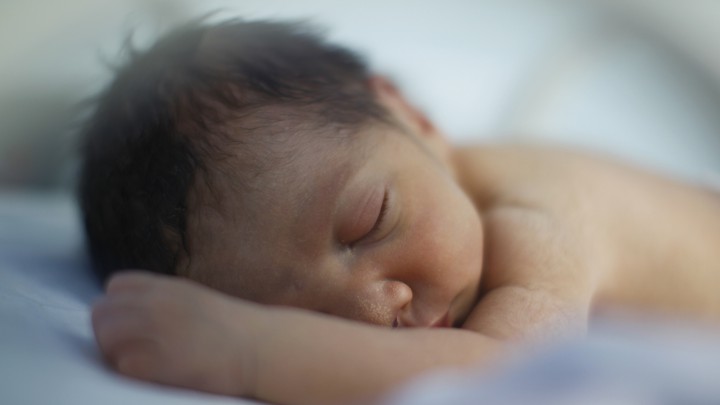
Infants spend most of their time sleeping, waking up for just a few hours total every day. A lot of growth happens during those spans of shut-eye, though. Research shows that sleep is just as formative for babies’ development as are the scattered bouts of consciousness when their eyes are open and their ears are perked up. As with adults, sleeping likely helps infants retain or protect memory and learn language; some evidence also suggests it promotes healthy physical growth. Technological advances are helping to shed more and more insight on, as the University of Washington professor of early-childhood learning Patricia Kuhl has put it, “the infinite number of secrets” contained in babies’ brains.
One secret that those advances have yet to uncover: whether babies dream—and, if they do, what they dream about. “Getting inside the head of a baby,” wrote the science journalist Angela Saini in a 2013 piece for The Guardian, “is like deciphering the thoughts of a kitten.” Brains are composed of so many intangible phenomena, and the technologies used to measure the stuff that is tangible (like brain-scanning machines) are difficult to use on babies. The resulting mystery has made the topic an endless source of intrigue—and of pointed disagreement— among many researchers.
During sleep the mind is a “remarkable engine of problem solving.”
In the 1960s, as the journalist Alice Robb explains in her forthcoming book Why We Dream, the psychologist David Foulkes theorized that children seldom remember their dreams before age 9. Foulkes continued his research into pediatric dreaming over the decades and in his 2002 book on the topic concluded that humans are dreamless in their first few years of life.
Just because they can “perceive a reality,” he wrote, doesn’t mean they “can dream one as well.” Instead, he found that children don’t start dreaming until they’re a few years old and can imagine their surroundings visually and spatially. Even then, he argued, the dreams tend to be static and one-dimensional, with no characters and little emotion. It isn’t until age 7 or so, according to Foulkes, that humans start to having graphic, storylike dreams; this phase of life is also when children tend to develop a clear sense of their own identity and how they fit into the world around them.
Still, in recent years, there’s been growing scientific recognition of babies’ capacity to “know, observe, explore, imagine and learn more than we would ever have thought possible,” writes the UC Berkeley child psychologist Alison Gopnik. Insight into the science of dreaming has also evolved, with the body of research broadening and challenging some of Foulkes’s conclusions. In 2005, for example, The New York Times published a Q-and-A with Charles P. Pollak, the director of the Center for Sleep Medicine at New York-Presbyterian/Weill Cornell Medical Center. “Yes, as far as we can tell,” he said when asked whether babies dream, noting that “it is a well-based inference” that they do so during the phase of sleep characterized by rapid eye movements, or REM.
REM sleep is when most dreaming occurs for humans. During this phase, the body becomes immobile and breathing and heart rate become irregular. According to Kelly Bulkeley, a psychologist of religion who studies dreams, REM sleep is also believed to help people consolidate their memories and mentally digest them, though sometimes in strange and seemingly illogical ways. Research dating back to the 1960s on the purpose of REM sleep for babies in particular has found that it supports brain development, helping infants to convert their experiences and observations during conscious hours into lasting memories and skills. Perhaps that’s why babies experience much more REM sleep than adults do—about half of babies' sleeping hours are spent in REM sleep, compared with about 20 to 25 percent for older humans. “The commonsense view,” as a result, “is that yes, babies are dreaming—they just don’t have language to be able to communicate that,” Bulkeley says.
Those who dispute the idea that babies dream, according to Bulkeley, often point to the fact that the visual images humans create in their brains during sleep are informed by their waking realities. That’s partially what Foulkes may have been getting at: Since babies have such little emotional and sensory experience to draw from, there’s not a lot of material to transform into a dream. But Bulkeley cited evidence suggesting that dreams serve at least in part as the body’s instinctive mechanism for protecting itself from hypothetical dangers. “The biological function of dreaming is to simulate threatening events, and to rehearse threat perception and threat avoidance,” wrote the Finnish neuroscientist who first advanced this theory, in 2000; in “our ancestral world,” he concluded, short life spans and constant danger made this dreaming mechanism advantageous.
In this view, when a person has a nightmare in which she’s running away from someone, for example—a dream theme that’s found across cultures and especially among children—that may be a way for her mind to practice in case she needs to escape a threat in reality. If that’s the case, then it’s conceivable that babies dream as a result of natural selection. After all, some studies indicate that other mammals and birds dream, too.
A team of scientists in Japan is trying to understand why we sleep.
But getting a definitive answer to this question of whether babies dream isn’t feasible, at least with today’s technology. Some of the best available data on adults’ dreams come from self-reporting in the form of surveys or daily journals, notes Rebecca Gomez, a psychology professor who directs the University of Arizona’s Child Cognition Lab—information that’s impossible to get from babies, who don’t begin to use abstract words until age 3 or so. Scientists who study dreams have benefitted from significant technological advances like those in machine learning that are starting to help empirically illustrate what’s happening in the brain during that process. But again: “You can’t just put infants in a scanner and have them do a test,” Gomez says.
Still, Bulkeley is optimistic that these scientific obstacles will start to recede as the technology continues to evolve, helping to solve a puzzle wondered about not only by psychology researchers but also by everyday moms and dads. Witnessing a sleeping newborn twitch her finger or flutter her eyelid is one of the myriad moments that emphasizes for parents that they’re raising a human—a person who is developing consciousness and reasoning, a sense of morality and social intelligence. Until that science comes around, though, just what they may dream about on their way to full personhood will remain a mystery.
We want to hear what you think about this article. Submit a letter to the editor or write to letters@theatlantic.com.
